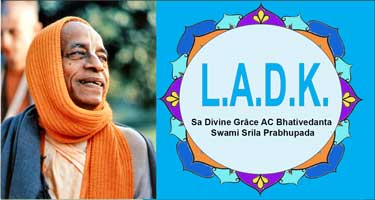
TRANSLATION
She then reached her father’s house, where the sacrifice was being performed, and entered the arena where everyone was chanting the Vedic hymns. The great sages, brāhmaṇas and demigods were all assembled there, and there were many sacrificial animals, as well as pots made of clay, stone, gold, grass and skin, which were all requisite for the sacrifice.
PURPORT
When learned sages and brāhmaṇas assemble to chant Vedic mantras, some of them also engage in arguing about the conclusion of the scriptures. Thus some of the sages and brāhmaṇas were arguing, and some of them were chanting the Vedic mantras, so the entire atmosphere was surcharged with transcendental sound vibration. This transcendental sound vibration has been simplified in the transcendental vibration Hare Kṛṣṇa, Hare Kṛṣṇa, Kṛṣṇa Kṛṣṇa, Hare Hare/ Hare Rāma, Hare Rāma, Rāma Rāma, Hare Hare. In this age, no one is expected to be highly educated in the Vedic ways of understanding because people are very slow, lazy and unfortunate. Therefore Lord Caitanya has recommended the sound vibration Hare Kṛṣṇa, and in the Śrīmad-Bhāgavatam (11.5.32) it is also recommended: yajñaiḥ saṅkīrtana-prāyair yajanti hi sumedhasaḥ. At the present moment it is impossible to gather sacrificial necessities because of the poverty of the population and their lack of knowledge in Vedic mantras. Therefore for this age it is recommended that people gather together and chant the Hare Kṛṣṇa mantra to satisfy the Supreme Personality of Godhead, who is accompanied by His associates. Indirectly this indicates Lord Caitanya, who is accompanied by His associates Nityānanda, Advaita and others. That is the process of performing yajña in this age.
Another significant point in this verse is that there were animals for sacrifice. That these animals weremeant for sacrifice does not mean that they were meant to be killed. The great sages and realized souls assembled were performing yajñas, and their realization was tested by animal sacrifice, just as, in modern science, tests are made on animals to determine the effectiveness of a particular medicine. The brāhmaṇas entrusted with the performance of yajña were very realized souls, and to test their realization an old animal was offered in the fire and rejuvenated. That was the test of a Vedic mantra. The animals gathered were not meant to be killed and eaten. The real purpose of a sacrifice was not to replace a slaughterhouse but to test a Vedic mantra by giving an animal new life. Animals were used to test the power of Vedic mantras, not for meat.

